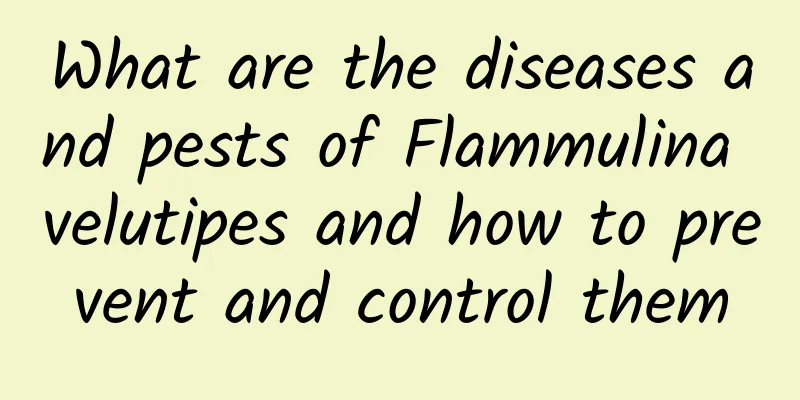What are the diseases and pests of Flammulina velutipes and how to prevent and control them

|
Today I will tell you about the various pests that Flammulina velutipes encounters during cultivation, as well as the prevention and control methods. Of course, it will be helpful to everyone. I think you should take a good look at it: 1. Select excellent disease- and insect-resistant strains. 2. Choice of location for mushroom cultivation room The mushroom house must be built in a north-south long strip, which is good for ventilation. At the same time, pay attention to the environmental hygiene around the mushroom house, and do not build the exit near the compost house and livestock house. Keep it away from the brewing koji factory, otherwise it is easy to be infected by bacteria. 3. Disinfection of the cultivation room The cultivation room must be fumigated and sterilized the day before use. The specific method is: 1. Formaldehyde and potassium permanganate fumigationGenerally, 8 ml of 40% formaldehyde and 5 g of potassium permanganate are required for each cubic meter of room for fumigation. You can also use 210 ml of formalin stock solution, 210 g of quicklime, and 21 ml of concentrated sulfuric acid for every 10 square meters. It is important to add lime and formalin first, and then add concentrated sulfuric acid, which will be vaporized immediately after adding. When fumigating, be sure to seal up the leaking seams of doors and windows. 2. Sulfur dioxide fumigationThe method is to burn sulfur in the cultivation room and use the sulfur dioxide it produces for disinfection. Place a ceramic container in the room, put paper or wood shavings on it, add sulfur, and then ignite the paper or wood shavings for fumigation. Because sulfur dioxide gas is heavier than air, once it is dispersed into gas, it will sink, so the container burning sulfur is best placed above the cultivation room. This gas will corrode metal and clothing, so you must be careful when disinfecting. 3. Disinfection with bleachHigh-efficiency bleaching powder is lime chloride and magnesium chloride, containing about 40%-80% effective chlorine. The method of use is to add 1 gram of bleaching powder to 1.8 liters of water, let it stand for 1-2 hours, take the supernatant and spray it all over the room, spraying 1 liter per square meter. Inside and outside the mushroom house, the cultivation racks should be fully sprayed with 5% copper sulfate solution. 4. Cultivation and Management1. Adjustment of temperature and humidity High temperature and high humidity are the best environmental conditions for the growth of fungi. When the outside temperature is high, the relative humidity of the mushroom house should be lowered, generally controlled at around 85%-90%. If the humidity is too high, various molds will occur quickly, which will inevitably affect the yield and quality of Flammulina velutipes. Also pay attention to ventilation in the mushroom house to keep the indoor air fresh. 2. Remove contaminated bottles and bags. Bottles and bags contaminated by bacteria in the mushroom house must be removed from the house in time, burned or buried. Do not dig bottles or bags in the mushroom house. Otherwise, the spores of bacteria will spread to the entire mushroom house and contaminate other bottles and bags. 3. After each batch of Enoki mushrooms is harvested, the room must be cleaned and fumigated. 4. Bleach and oxytetracycline can be added to the water used for cultivation and management to prevent the occurrence of diseases and bacteria. 5. Kill pests in timeThe main pests that harm Flammulina velutipes are mushroom ropes, sharp-eyed mushroom gnats, and mites. These pests are particularly severe when the temperature rises. During the period of mycelium spreading, as long as you see adult insects flying out, you should use insecticides to control them. Dichlorvos is an ideal drug, and malathion, diazinon, diflubenzuron or cypermethrin can also be used. Stop using it when mushroom buds appear. |
<<: Black fungus fried day lily step by step diagram
>>: Common diseases of edible fungi and their prevention and control
Recommend
The disadvantages of drinking soda The disadvantages of drinking soda frequently
In summer, we love to drink soda, which tastes go...
How to eat kiwi fruit? The efficacy and function of kiwi fruit
Kiwi is a fruit with extremely high nutritional v...
The efficacy, function and nutritional value of sweet potato porridge
Sweet potato porridge has the effects of promotin...
Gypsum mung bean porridge
I believe many friends are very interested in gyp...
The advantages and disadvantages of eating lychees
Lychee is one of the most important fruits in sou...
How is CMD Radio? CMD Radio Review and Website Information
What is CMD Radio? If you don't know what a co...
The nutritional value and efficacy of bamboo shoots The benefits of eating bamboo shoots
Bamboo shoots have been known as a delicacy since...
White Fungus and Lean Meat Porridge
White fungus and lean meat porridge is a porridge...
How is Alcon? Alcon reviews and website information
What is Alcon? Alcon is a world-renowned supplier ...
How to pickle radish
How to pickle radish? Let me give you a detailed ...
The benefits and effects of egg fruit and the benefits of eating egg fruit
The egg fruit is a herbaceous vine fruit that usu...
The efficacy and function of fire ginseng peel
The fire guava, also known as African honeydew me...
What is the Australian Premier League like? Australian Premier League reviews and website information
What is the Australian Premier League website? The...
The efficacy and method of apple and pear syrup
Every autumn, I always see some people drinking a...
What are the benefits of eating raw onions?
Everyone must have eaten onions. Onions are also ...









